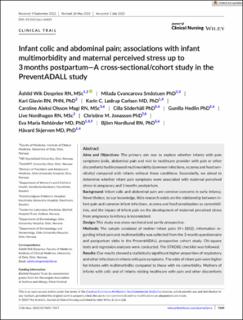| dc.contributor.author | Despriee, Åshild | |
| dc.contributor.author | Småstuen, Milada Cvancarova | |
| dc.contributor.author | Glavin, Kari | |
| dc.contributor.author | Carlsen, Karin Cecilie Lødrup | |
| dc.contributor.author | Magi, Caroline Aleksi Olsson | |
| dc.contributor.author | Söderhäll, Cilla | |
| dc.contributor.author | Hedlin, Gunilla | |
| dc.contributor.author | Nordhagen, Live Solveig | |
| dc.contributor.author | Jonassen, Christine M | |
| dc.contributor.author | Rehbinder, Eva Maria | |
| dc.contributor.author | Nordlund, Bjørn Kristian | |
| dc.contributor.author | Skjerven, Håvard Ove | |
| dc.date.accessioned | 2024-02-07T11:28:18Z | |
| dc.date.available | 2024-02-07T11:28:18Z | |
| dc.date.created | 2023-09-20T13:53:22Z | |
| dc.date.issued | 2023 | |
| dc.identifier.citation | Journal of Clinical Nursing (JCN). 2023, 32 (19-20), 7605-7617. | en_US |
| dc.identifier.issn | 0962-1067 | |
| dc.identifier.uri | https://hdl.handle.net/11250/3116146 | |
| dc.description.abstract | Aims and Objectives: The primary aim was to explore whether infants with pain symptoms (colic, abdominal pain and visit to healthcare provider with pain or other discomforts) had increased multimorbidity (common infections, eczema and food sen- sitivity) compared with infants without these conditions. Secondarily, we aimed to determine whether infant pain symptoms were associated with maternal perceived stress in pregnancy and 3 months postpartum.
Background: Infant colic and abdominal pain are common concerns in early infancy. Nevertheless, to our knowledge, little research exists on the relationship between in- fant pain and common infant infections, eczema and food sensitization as comorbidi- ties, and the impact of infant pain on the development of maternal perceived stress from pregnancy to infancy is inconsistent.
Design: This study was cross-sectional and partly prospective.
Methods: The sample consisted of mother–infant pairs (N = 1852); information re- garding infant pain and multimorbidity was collected from the 3-month questionnaire and postpartum visits in the PreventADALL prospective cohort study. Chi-square tests and regression analyses were conducted. The STROBE checklist was followed. Results: Our results showed a statistically significant higher proportion of respiratory and other infections in infants with pain symptoms. The odds of infant pain were higher for infants with multimorbidity compared to those with no comorbidity. Mothers of infants with colic and of infants visiting healthcare with pain and other discomforts reported statistically significant higher perceived stress by 3 months compared with mothers of infants with no reported pain.
Conclusion: Our results indicate an association between infant pain symptoms and the presence of infections. Mothers of infants with colic and visiting healthcare had higher perceived stress compared to the no pain group.
Implications for Practice: Our study indicates that infant pain is associated with infant multimorbidity and maternal perceived stress, which may be useful when planning diagnostic, treatment and coping strategies in infant and family care.
Patient or Public Contribution: The PreventADALL is a collaborative study with gov- ernmental and patient organisation representation. Selected infants with parents were also contributing during calibrating courses on eczema assessment for the data collectors. | en_US |
| dc.language.iso | eng | en_US |
| dc.rights | Attribution-NonCommercial-NoDerivatives 4.0 Internasjonal | * |
| dc.rights.uri | http://creativecommons.org/licenses/by-nc-nd/4.0/deed.no | * |
| dc.title | Infant colic and abdominal pain; associations with infant multimorbidity and maternal perceived stress up to 3 months postpartum—A cross-sectional/cohort study in the PreventADALL study | en_US |
| dc.type | Peer reviewed | en_US |
| dc.type | Journal article | en_US |
| dc.description.version | publishedVersion | en_US |
| cristin.ispublished | true | |
| cristin.fulltext | original | |
| cristin.qualitycode | 2 | |
| dc.identifier.doi | 10.1111/jocn.16825 | |
| dc.identifier.cristin | 2177128 | |
| dc.source.journal | Journal of Clinical Nursing (JCN) | en_US |
| dc.source.volume | 32 | en_US |
| dc.source.issue | 19-20 | en_US |
| dc.source.pagenumber | 7605-7617 | en_US |

